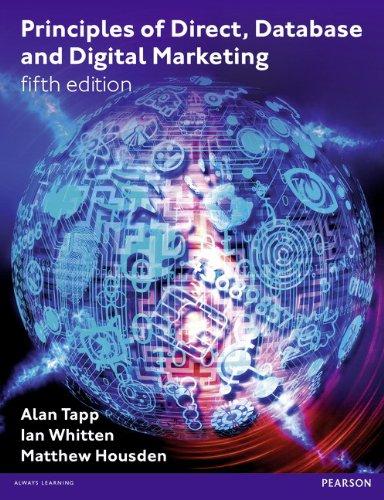Even if only 10 per cent of the hype is true, UK supermarket giant Tesco has still
Question:
Even if only 10 per cent of the hype is true, UK supermarket giant Tesco has still had huge success with its loyalty card Clubcard. Not many humble cards have books written about them: Tesco’s direct marketing agency Evans Hunt Scott has teamed up with Clive Humby of analyst DunnHumby (now owned by Tesco) to write the story of Clubcard – such is the interest. Clubcard’s fame is now such that it is probably the best known example of direct marketing in British commercial history.
Tesco Clubcard was launched in 1995 under conditions of some secrecy. After a few trials the national launch was carried out in a wave of publicity. Now, every quarter Tesco sends out a statement to its 10 million regular Clubcard users, but only one in every hundred of the recipients will receive the same communication. It now mails 100 000 variants of its quarterly statement – arguably, therefore, getting closer all the time to the idea of ‘perfect’ 1–1 marketing.
The investment in Tesco Clubcard was driven not by the idea of loyalty from a discount card, but by the power of the data gathered. Not surprisingly, it is in the marketing area that the biggest benefits of the information are being felt. The principle is that Tesco is now able to understand its customers’ needs in more detail and, hence, improve the relevance of products, sales promotions and communications to individuals.
Tesco collects data down to single product/ item level and can, therefore, link individual products to individual customers. It also collects personal details such as lifestage, household details, occupation and so on, on the joining form.
Tesco quickly realised it was faced with a mountain of data and, in order to cope, it has developed a hierarchy of segmentations. The top level broad segments relate household details, in particular lifestage, to broad shopping habits such as breadth and intensity of shop. So, we have ‘single adults’, ‘urban professionals’, ‘pensioners’ and so on. Shoppers have also been categorised into ‘price sensitives’, ‘foodies’, ‘heavy category users’ or ‘loyalists’
of particular brands (Mitchell, 2002). For each segment, using FRAC analysis, marketers can assess average spend, frequency of visit, lifetime value, retention rate and similar variables, and then monitor the impact of marketing initiatives on these variables over time.
Further sub-segments could also be identified, based on shopping behaviour. These segments may be described in terms of customers’ use of competitor supermarkets as well as Tesco. The lifestage data can lead to detailed tracking of, for example, families, the key target for Tesco. The focus of the analysis covers product groups as well as customer groups.
In theory, therefore, Tesco could take any particular product, say milk, and assess penetration, spend and purchase frequency of any of the customer segments against this. For example, a family who fell in the ‘high behaviour’ category may spend, let us say, over £6 on milk in about four visits each month. Tesco could compare this data with ‘external market research’ as well as internal profiles that would indicate potential take‑up of the product.
The outcome may be a list of customers whom the analysis has identified as seeming to be under-purchasing milk compared with a (researched) expected volume. Interestingly, Tesco has learned that it is far easier to move a top shopper to higher levels of spending than it is to get a non-shopper into the store.
The analysts have also carried out detailed cluster analyses that map out relationships between the different product groups. Therefore, a cluster of a particular profile of customers who tend to purchase milk, bread and staples regularly, but only occasionally buy, say, ready meals, could be identified. This series of customer clusters, or segments, may cut across the broad scale top line segments described earlier, to provide a new focus for marketing activity.
The Clubcard is used to communicate more effectively with customers. Promotions are targeted more precisely – for example dog food is targeted at dog owners – using coupons given out at the checkout and with Clubcard statements. These are delivered at the same time to all Clubcard users, four times each year. Executives joke that it is like Christmas four times each year, such is the uplift in traffic.
Stock control, product take‑up and comparative store performance are just some of the areas where the data is helping the business. Different stores are arranged differently according to the customer data. Hence, Tesco effectively lets customers decide what each store should stock, fundamentally changing its supply chain from ‘push’ to ‘pull’.
More recently, Tesco now offers specific details of segments of customers, minus names and addresses, plus analyses of direct marketing tests, to its suppliers – provided customers give permission of course. Manufacturers such as Kraft and Procter & Gamble are keen to take advantage of such offers. This, plus Tesco’s sales of advertising space in its Clubcard magazine, makes the retailer a source of marketing research and a media owner, as well as a retailer. It also points to possibly increased links with suppliers in the future.
In March 2002, Tesco signed a deal with Air Miles, allowing points from Clubcard to be redeemed for air travel. It saw a 400 per cent uplift in traffic to its website and a surge in Clubcard members, illustrating the continuing power of Air Miles in attracting customers.
Questions
1. Why is the term ‘loyalty card’ a misnomer?
2. What are the keys to Clubcard’s success?
3. How has Clubcard changed Tesco’s non-marketing processes?
4. Identify the different segmentation approaches adopted by Tesco. How would you describe its segmentation strategy?
Step by Step Answer:

Principles Of Direct Database And Digital Marketing
ISBN: 9780273756507
5th Edition
Authors: Alan Tapp





